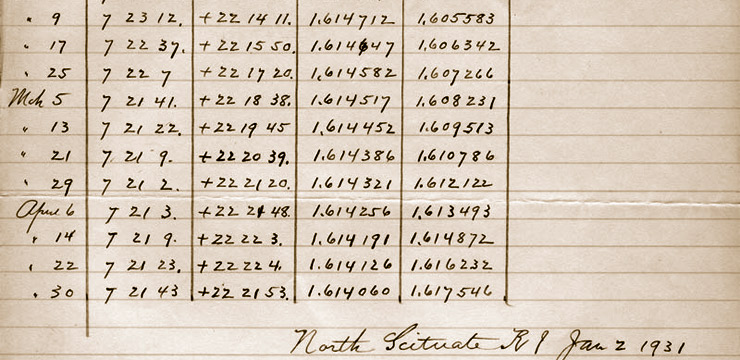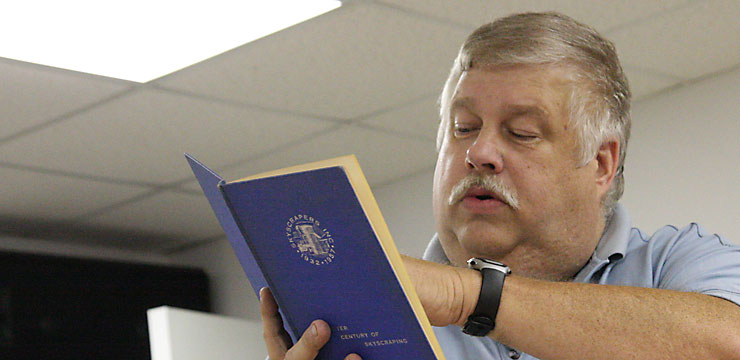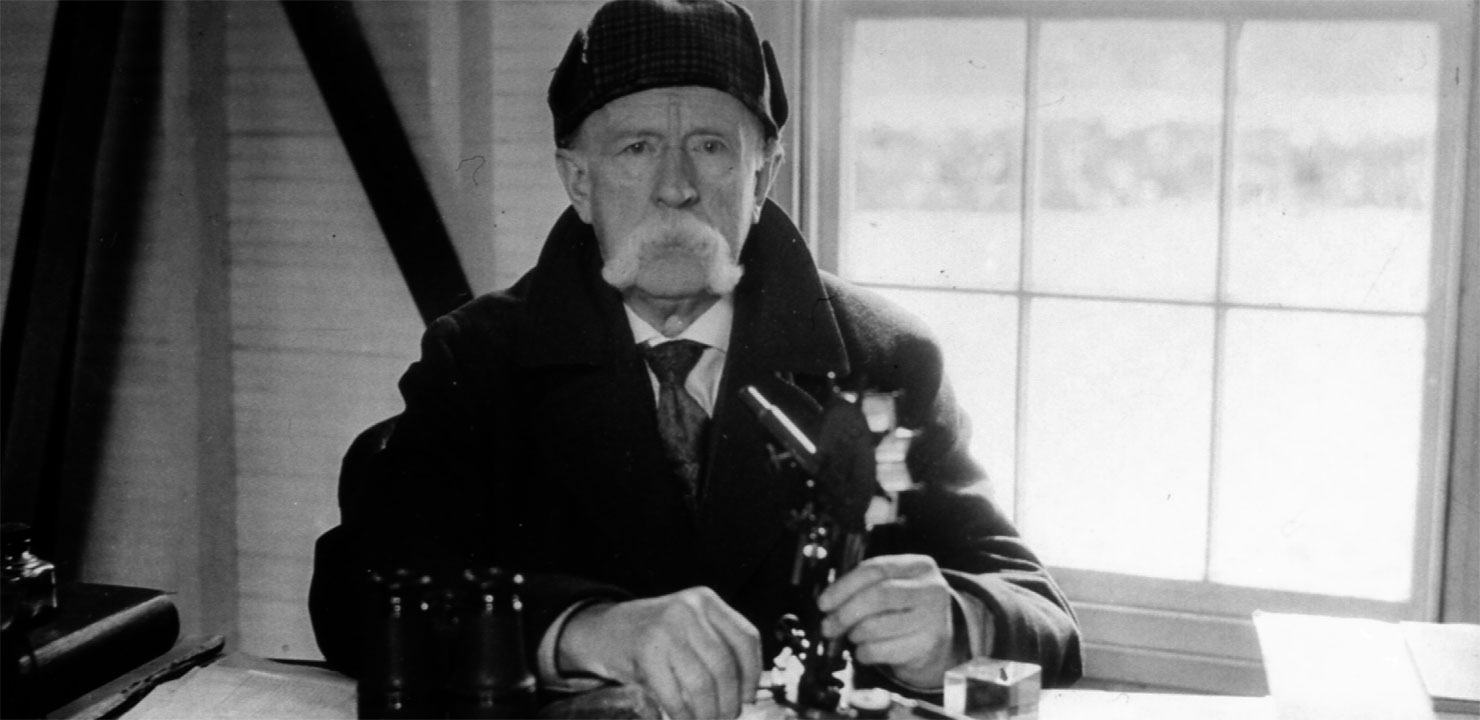
The “Conjunction” of Frank Seagrave and Percival Lowell
April 2006 :
Soon after I joined Skyscrapers, which is now more than 31 years ago, I became very interested in the history of our organization and the legacy of Frank Evans Seagrave. On occasion, long time member and then Skyscraper Historian Bill Gucfa would present a few historical tidbits at one of our monthly meetings about this noted astronomer and his accomplishments. Bill and I were kindred spirits from the start, and we became good friends. Since Bill had little or no spare time to do further research, he encouraged me to carry the torch.
At Bill’s direction I visited the Rhode Island Historical Society’s library where I found many articles by and about Seagrave among the microfiched archives of The Providence Journal.
Much of the initial information I gleaned about Frank Seagrave came from an article published in the August 16, 1934 edition of The Providence Journal. That story announced Frank Seagrave’s death on the evening before, following a major operation. He was 75 years old. After reading the Journal’s recap of Seagrave’s life and achievements, I became intrigued with this individual for whom our observatory is named.
More and more articles were uncovered as I tediously cross-referenced the many reels of microfiche. One, and only one, carried a statement which read, “It was Percival Lowell’s wish, that when his planet “X” was discovered, his friend Frank Seagrave would compute its orbit.” I never saw this information reported in any other article, nor in any of the letters I researched in the collection of E.C. Pickering up at Harvard. It might be in there somewhere. The collection is quite vast, since Pickering was Director of the Harvard College Observatory (HCO) from 1877 until 1919.
When noted author Bill Sheehan visited Skyscrapers for Astro Assembly 2005, Dan Lorraine had an opportunity to enlighten him on the legacy of Frank Seagrave. Dan mentioned the possible Lowell connection, and asked Bill if he had any contacts at Lowell Observatory. Sheehan did, and he promised to see if he could uncover any collaborative materials.
Bill retrieved some documents from Lowell Observatory that not only prove Lowell and Seagrave were frequent correspondents, but also that Seagrave often visited Lowell when both of them were in Boston.
So how did it come to pass that the orbits of these two gentlemen would resonate? As I write this story now, I do not know when Lowell and Seagrave first corresponded or met. I hope to uncover that information at a later time. But to start this story we must begin with the life of Percival Lowell and the paths he chose during his lifetime.
Lowell was five years older than Seagrave, having been born in 1855. In 1876 he graduated from Harvard with a degree in mathematics. Though he had an interest in astronomy as a child, he didn’t immediately pursue that career after graduation. He spent a year in Europe and then returned to work as treasurer in his grandfather’s cotton mill, a job he kept for six years. Then he was fortunate to visit the far east, including Japan and Korea. He returned to Boston in 1893.
Sometime during his far east travels Lowell caught the Mars bug! He learned of Schiaparelli’s observations of “canals” on our second nearest planetary neighbor. Though we know that a teenage Lowell observed Mars from the roof of the family mansion in 1870, there is currently no record indicating he ever actively pursued interest in the planet until 1894. However, Lowell did realize one very important fact. Steady seeing was required to discern great detail on the Martian surface. Through his connections at Harvard, he, William Pickering and A.E. Douglass traveled to the southwest in 1894 to find a location with great seeing to observe the opposition of Mars that year. Lowell’s favorite spot was a hill in Flagstaff, Arizona, now known as Mars Hill. This spot is the location from which Lowell performed all his “infamous” Mars observations.
Though Lowell spent much of his time out at Flagstaff, he did maintain an office in Boston. About 1905, Lowell began another quest. Because of small perturbations in Neptune’s orbit, it was suggested another “Trans-Neptunian planet” existed. Lowell, with his mathematics background, and with the help of colleagues, tried to derive a possible orbit. They even took photographic plates in 1906 of an area of sky where they thought planet “X” might be located, but with no results. Revisions were made, and on December 28, 1908, Lowell wrote of his own calculations, “The results so far are both interesting and promising.”
Now let’s review highlights of Frank Seagrave’s life and see how the “conjunction” of these two great individuals unfolded. Frank Evan Seagrave was born in Providence, Rhode Island on March 29, 1860. Frank attended a private school where he acquired a knack for mathematics. On October 26, 1874, at the age of 14, his interest in astronomy was awakened by an eclipse of the moon. So great was this new interest that his father bought him a 3-inch refractor soon after. It is reported that Frank observed every fair night.
In 1875, Frank (then only a youth of 15 years old) began traveling to the Harvard College Observatory twice a week, where, even though he wasn’t enrolled as a student, he was given access to the library and instruments. He obviously knew Director Pickering and Assistant Director Leonard Waldo. Frank even went on several Harvard eclipse expeditions.
Many parents encourage their children’s hobbies, but Frank must have really impressed his dad. For as you may already know, Frank’s father bought him an 81/4-inch Alvan Clark refractor (which Skyscrapers owns today) for his 16th birthday (March 1876) and erected an observatory at 119 Benefit Street in Providence two years later, in May 1878. Present for the dedication was Leonard Waldo and Alvan G. Clark himself.
Over many decades Seagrave was very well known up at Harvard, having sent many letters to Pickering containing computations for the orbits of comets (including Halley’s Comet in 1910) and asteroids. In my opinion it was probably inevitable that he and Lowell would eventually meet. Though Seagrave had no formal education after private school, he and Lowell had much common ground. They both had a flair for mathematics, and both loved astronomy.
Mars continued to be a hot topic, and Seagrave was very interested in the planet. In fact, Seagrave (now 47 years old) gave a local talk about Mars on July 9, 1907, where he spoke of Lowell’s observations and those of his own. Though Lowell (now 52) had an office in Boston at the this same time, I have not as yet uncovered any correspondence between these two gentlemen during this period.
However, less than eight years later, when Seagrave was “working” as an assistant at HCO (1915 - 1917), it is apparent from their letters to one another, and from those to other astronomers at a much later date, that in the intervening years Lowell and Seagrave had become fast friends.
The first verification of the Seagrave/Lowell connection (ages 55 and 60 respectively) that I have received so far can be found in a couple of postcards that Seagrave sent from Boston to Lowell at Flagstaff in January and February 1915. It is evident from the way the text is written that Lowell and he are friends. In fact, one of the postcards does have the salutation, “My Dear Friend.” Seagrave was trying to compute a new asteroid’s orbit. Frank wrote,
”Well how do you do. Hope you arrived safe at Flagstaff. I am at work on that asteroid orbit and will send figures to you when finished. Thank you very much for all you have done and are doing for me. Let us hear from you. Hope you will find X.”
Seems it wasn’t an asteroid but a comet, for Lowell sent a response to Seagrave on March 3, 1915 saying,
“So the Harvard ‘harvest on their plates’ have made an asteroid into a comet! That’s going some. And I am told The Herald tried to credit us with the transformation. No! No! we are only astronomers, not astro-misnomers. I wish this definition, which I just dropped off the end of my obliging pen, had occurred to me yesterday when I wired a modest denial of such ultra-heavenly powers with a ‘please correct’ to the Herald.”
Lowell died at age 61 on November 12, 1916. Frank continued his correspondence with Dr. Slipher, the new Director of Lowell Observatory. On April 23, 1917, Seagrave wrote to Slipher,
“Have you taken any observations of Mellish’s latest Comet? I want some positions. The computed orbit is away off, and I wanted to see what I could make out of it. Three positions, say a week apart. How are you getting along these days since Dr. Lowell died? I do miss him so. I am yours.”
In a follow-up letter in an obvious response to Slipher’s answer, Seagrave wrote,
“Thank you so much for your letter that I received Sunday morning. If you should at anytime find any conspicuous object that you think is “X” please send me some positions. Dr. Lowell many times promised me that I should be the first one to work on its orbit when discovered.”
The search for Planet “X” continued. Finally, on February 18, 1930, Clyde Tombaugh discovered Lowell’s distant world by “blinking” photographic plates he had pains-takenly exposed. As Clyde told Skyscraper members when he visited Seagrave Observatory for Astro Assembly in 1987, until he informed his colleague Dr. C. O. Lampland across the hall from his office and then his boss V.M. Slipher, for 45 minutes he was the only person in the world who knew of the new planet’s existence.
This monumental discovery was announced to the world on March 13, 1930. I’m sure Seagrave, now 70 years old, was quite excited, because it had been 25 years since Lowell had begun calculating a possible orbit for the now named Pluto. Though I do not currently have any correspondence from Lowell to Seagrave during their many years of friendship that states that Seagrave would be allowed to be one of the first to compute Pluto’s orbit, it doesn’t seem to me to be a leap of faith that it had been verbally promised to Frank. In fact, all along Seagrave may have been contributing calculations to Lowell on potential places in the heavens to search for planet “X.” Since Lowell had died some 14_ years previous, who would know of his promise to Seagrave if it wasn’t written down? Seagrave most certainly remembered.
In a letter to Dr. Slipher in Flagstaff on March 14, 1930, Seagrave wrote,
“Can you send me some positions of planet X, the newly discovered one beyond the planet Neptune. Many years ago (say from 1912 to 1915) the late Dr. Lowell promised me that if the Lowell Observatory ever found X that he would let me be one of the first to compute its orbit ... Thank you in advance for anything you can send me in relation to this most interesting planet. I am yours. Frank E. Seagrave."
Well, Seagrave didn’t immediately receive an answer to his query. One month later, on April 15, 1930, an impatient Seagrave sent another letter to Dr. Slipher at Lowell Observatory in Flagstaff. He wrote.
“About the middle of March I sent you a letter asking for some photographic positions of the outer Neptunian planet, or the new Asteroid, or the new Comet, whatever it proves to be. Up to date I have never heard from you. I am wondering why as the newspapers all mention positions secured during January and February. The last time I was with Dr. Percival Lowell was late in September 1916. At that time he was getting ready to leave Boston (I was at the Lowell Observatory Office, 53 State St, Boston with him.) for Flagstaff, and was to stop at three or four places on the way to lecture. He showed me his computations in relation to the outer Neptunian planet, and said to me, “Seagrave, if the Lowell Observatory is the Observatory that will first find this planet, you will be the first one to compute its orbit.” No writing to this effect. Only a verbal statement. I am wondering why you did not send me some positions as you seem to have sent some to Dr. Miller of Sproul. Dr. Van Biesbroeck of Yerkes Observatory sent me four positions. From two of these positions one of March 16 and one of March 20, I have computed approximate circular elements as per enclosed sheet. The enclosed look “OK,” and all check “OK”.” Here Seagrave supplies some formulas and provides the sheet of elements. In closing, Seagrave writes, “I shall hope to hear from you soon, and tell me the very latest. Is it “X”, an Asteroid of enormous size, or a Comet great in size and nearly 40 units from the Sun. I am yours. Frank E. Seagrave.”
Slipher finally responded to Seagrave on April 19.
“It was my aim to get off to you yesterday some of the early positions of Lowell’s Transneptunian object, apparently planet X, but the day was not long enough. In fact, as you can imagine the days have for weeks all been too short for us to get done what should have been done, and we, in consequence have had to appear unfriendly or discourteous to many good people like yourself. And just now your second letter has come to hand with your orbit, for which we thank you.
Even before making the announcement of the finding of what has been appearing to be Dr. Lowell’s Planet X, it seemed to me that we here should determine for it a preliminary orbit. This because it seemed best for Lowell Observatory to find it out and make it known if the object were thus shown to be less important than it had appeared. Dr. Lowell and the Observatory had put so much into the problem as to appear to justify this policy. We have felt that in such a case special carefulness was necessary and we have tried to be careful. (This, of course, concerns the general matter, not the orbit.)
Dr. Miller was here at the Observatory and worked with us on the orbit. Accurate positions for orbit purposes were not sent out although besides yours there were many urgent requests for early positions. The enclosed positions are being mailed to you in advance of any other person (this is, of course, in confidence). And I hope you will feel that we have tried to be fair. We of course realized at the outset that you who compute orbits were better equipped to do such work, but the reasons given above decided our course. We hope that you will get from these early places and other more recent ones an improved orbit, and needless to say we shall be greatly obliged to you for letting us know what results you get. With best wishes. V.M. Slipher”
Seagrave responded to Dr. Slipper’s letter on April 30, stating,
”I thank you for the positions of planet “X” that you sent to me. I did not receive them until yesterday as the North Situate people neglected to forward your letter to me here. Too bad that we have not a larger arc to base orbit elements on. I will see what I can do. I am yours, Frank E. Seagrave, North Situate, RI and 8 Durham St., Boston, Mass.”
So, from what I have revealed to you in this story, Frank Seagrave and Percival Lowell were more than just associates. They were friends. And the verification of their collaboration and friendship is just one more highlight in my goal to complete the life story of Frank Evans Seagrave.
Now if I could only locate all his personal notes, observations and computations ...
Related Topics

From The Historian




